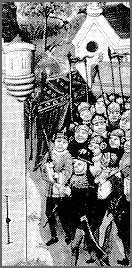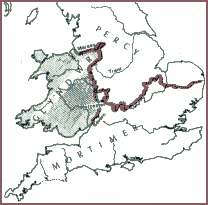
The revolt of Owain Glyndwr
A brief chronology, 1401-1415
 1401
1401On Good Friday 1401 Conwy castle was captured by Owain’s supporters, and held for two months (much to the embarrassment of the English administration). Owain emerged from hiding, and threatened Harlech and Caernarfon. Henry IV led a second expedition into Wales in October 1401, but again it achieved little.
In this year Owain captured his old enemy, Reginald Grey, who was ransomed for a massive 10,000 marks (£6,666). Then in June he defeated a force under Edmund Mortimer, the young earl of March, at Pilleth near Presteigne. This time the government procrastinated and Mortimer betrothed himself to Owain’s daughter (significant, as he could actually claim a better right to the English throne than Henry IV, who was a usurper). The revolt had by now extended into Glamorgan and Gwent. In August 1402 Henry IV led a third expedition into Wales, but it was forced to retreat by torrential rain, leading the English to suggest that Owain could control the weather by magic.
 1403
1403
This was another year of triumph for Owain, with raids in the
south and west. Conwy, Aberystwyth and Cardiff castles were besieged.
Henry led another raid in Wales, with the same results. Also
in this year Owain allied with the Percy family’s (earls
of Northumberland) revolt in England, which received a setback
with Hotspur’s defeat and death at the battle of Shrewsbury
on 21 July 1403. Also, Owain gained his first assistance from
the French, a further sign that his ambitions were being realised.
1404
This year was to be Owain's
high point. English control was limited to the coastal fringe,
and a few isolated castles. Harlech and Aberystwyth castles fell
at last. Owain could truly claim to be national prince, and so
held his first parliament at Machynlleth.
On 14 July 1404 he made a formal alliance with France. By the
end of the year John Trefor, bishop of St. Asaph, had joined
Owain’s cause.
After that, things began to go wrong. Owain concluded a "Tripartite Indenture" with Edmund Mortimer and the earl of Northumberland, agreeing to divide
 England and Wales between them,
an intention rather at odds with reality, especially after Percy’s
rebellion collapsed in May. A French force landed and marched
almost as far as Worcester, but was eventually obliged to withdraw.
England and Wales between them,
an intention rather at odds with reality, especially after Percy’s
rebellion collapsed in May. A French force landed and marched
almost as far as Worcester, but was eventually obliged to withdraw.
Support for the rebellion began to crumble and Owain suffered a string of military defeats. In 1407 the French alliance collapsed; in 1408 the last of the English rebels including Percy were killed and Harlech and Aberystwyth recaptured. The rebellion slowly petered out into localised incidents.